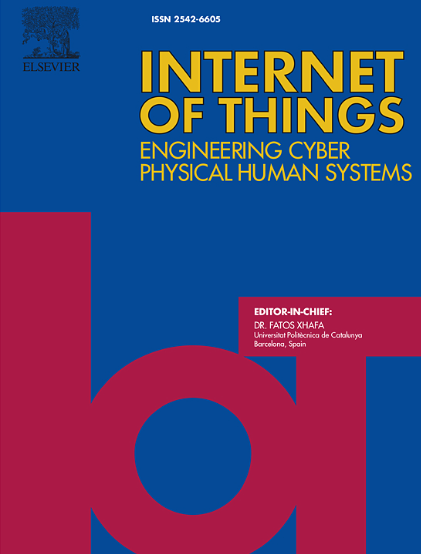一种基于半同构树的雾计算(SHTBFC)模型的重构算法以降低能耗
IF 6
3区 计算机科学
Q1 COMPUTER SCIENCE, INFORMATION SYSTEMS
引用次数: 0
摘要
在物联网中,由于大量传感器数据从设备传输到网络中的服务器,并且在服务器上执行传感器应用需要花费大量的计算资源,因此消耗了大量的电能。为了实现节能物联网,我们讨论了一种SHTBFC(半同构树型雾计算)模型,其中服务器和设备类型在同构雾节点树中相互连接。这里,根表示服务器,叶表示设备。因此,在SHTBFC模型中,并非所有节点都是同构的。每个雾节点通过处理子雾节点的输入数据来生成输出数据,并将输出数据传递给父节点。如果某个雾节点f由于故障导致行为不正常,则f的后代雾节点无法与祖先节点通信。为了从故障中恢复,提高性能,降低能耗,我们提出了一种TR (tree - restructuring)算法,将SHTBFC树重构为能耗更小的SHTBFC树。首先选取一个消耗SHTBFC树最大能量的目标雾节点。然后,在目标节点上执行三个TR操作中的一个,M(迁移)、R(复制)和X(扩展)操作。应用程序的能耗取决于应用程序进程的数量。应用程序组成的进程越多,TR算法得到的SHTBFC树中包含的雾节点越多。在评估中,我们显示了应用程序消耗最小能量的应用程序进程的数量。本文章由计算机程序翻译,如有差异,请以英文原文为准。
An algorithm to restructure the Semi-Homogeneous Tree-Based Fog Computing (SHTBFC) model to reduce the energy consumption
In the IoT (Internet of Things), a large amount of electric energy is consumed since a tremendous volume of sensor data is transmitted from devices to servers in networks and large computation resources are spent to execute sensor applications on servers. In order to realize the energy-efficient IoT, we discuss an (Semi-Homogeneous Tree-Based Fog Computing) model where types of servers and devices are interconnected in a tree of homogeneous fog nodes. Here, a root stands for a server and a leaf indicates a device. Thus, all the nodes are not homogeneous in an SHTBFC model. Each fog node generates output data by processing input data from the child fog nodes and passes the output data to the parent node. If some fog node does not behave correctly due to faults, the descendant fog nodes of cannot communicate with the ancestor nodes. In order to recover from the faults, improve the performance, and reduce the energy consumption, we newly propose a (Tree-Restructuring) algorithm to restructure an SHTBFC tree to an SHTBFC tree which consumes smaller energy. An objective fog node is first taken, which consumes the largest energy in an tree. Then, one of three operations, (migrate), (replicate), and (expand) operations is executed on the objective node. The energy consumption of an application depends on the number of application processes. The more processes an application is composed of, the more fog nodes are included in an SHTBFC tree obtained by the algorithm. In the evaluation, we show the number of application processes where an application consumes the smallest energy.
求助全文
通过发布文献求助,成功后即可免费获取论文全文。
去求助
来源期刊

Internet of Things
Multiple-
CiteScore
3.60
自引率
5.10%
发文量
115
审稿时长
37 days
期刊介绍:
Internet of Things; Engineering Cyber Physical Human Systems is a comprehensive journal encouraging cross collaboration between researchers, engineers and practitioners in the field of IoT & Cyber Physical Human Systems. The journal offers a unique platform to exchange scientific information on the entire breadth of technology, science, and societal applications of the IoT.
The journal will place a high priority on timely publication, and provide a home for high quality.
Furthermore, IOT is interested in publishing topical Special Issues on any aspect of IOT.
 求助内容:
求助内容: 应助结果提醒方式:
应助结果提醒方式:


